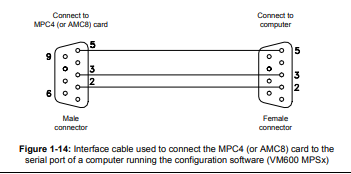
parkerQUICK START MANUAL VM600 machinery protection system (MPS)
is available at the rear of the rack, on the rear panel associated with the RPS6U power supply
or supplies.
NOTE: Refer to the VM600 system rack (ABE040 and ABE042) data sheet for further
information on the power supply check relay.
As shown in Figure 1-12, the connector for the power supply check relay has three pins that
provide access to the relay contacts, defined from left to right as COM, NO and NC.
Apart from the power supply check relay connector, the other components shown in
Figure 1-12 are mounted on the VM600 rack (ABE04x) backplane.
THE POWER SUPPLY CHECK RELAY IS SPECIFIED FOR OPERATION WITH SEPARATED
OR SAFETY EXTRA-LOW VOLTAGE (SELV) SYSTEM VOLTAGE LEVELS:
• MAXIMUM SWITCHING VOLTAGE OF ±30 VRMS / ±42.4 VAC(PEAK) OR 60 VDC
Handling cards
1.5.1 Card locations
The VM600 MPS rack (ABE04x) is a modular system with 21 card (VME) slots, designated
slot 0 to slot 20 (from left to right, as seen from the front). See Figure 1-4.
The front and rear card cages of the rack are partitioned by a backplane. Each side of the
back plane is equipped with connectors allowing modules and cards to be quickly and easily
installed.
The following elements are connected to the backplane by installing them from the front of
the rack:
• AMC8 analog monitoring card
• CPUM modular CPU card
• MPC4 machinery protection card
• RPS6U mains power supply unit
The following elements are connected to the backplane by installing them from the rear of the
rack:
• IOC4T input/output card, for use with the corresponding MPC4
• IOC8T input/output card, for use with the corresponding AMC8
• IOCN input/output card, for use with the corresponding CPUM
• IRC4 intelligent relay card
• RLC16 relay card.
If the ABE04x rack is intended for use as a condition monitoring system (CMS) as well as an
machinery protection system (MPS), it can contain additional hardware:
• XMx16/XIO16T extended monitoring card pairs.
NOTE: Further information on the condition monitoring system hardware can be found in
the VM600 condition monitoring system (CMS) hardware manual.
Operating personnel should remember to observe the handling
precautions mentioned in Handling precautions for electrostatic sensitive
devices on page x when handling cards.
Failure to do this may result in cards becoming damaged by electrostatic
discharges.
Before inserting a card in a rack, visually check that none of the connector
pins are ben
Communicating with a VM600 MPS
The VM600 MPS may be configured in several ways, depending on the hardware installed in
the VM600 rack (ABE04x). Figure 1-13 shows the various possibilities for communicating
with the system. In all cases, one of the VM600 MPSx software packages (MPS1 or MPS2)
is required to perform the configuration.
Figure 1-13 (a) shows the simplest VM600 MPS configuration. This is a stand-alone rack, that
is, one not containing a CPUM card. In this case, each MPC4 or AMC8 card in the rack must
be programmed individually from a personal computer over an RS-232 link
(see 1.7 Connecting to a computer).
Figure 1-13 (b) shows a rack containing a CPUM modular CPU card. An Ethernet link may
be established between the personal computer and the VM600 MPS via this card. The
connection is made on the front panel of the CPUM, hence at the front of the rack.
Communication between the CPUM and the MPC4 / IOC4T or AMC8 / IOC8T card pair takes
place over a VME bus on the rack backplane.
Figure 1-13 (c) shows a rack containing a CPUM modular CPU card and the corresponding
IOCN input/output card. A connection may be established between the personal computer
and the VM600 MPS via the IOCN. The connection is made on the IOCN panel, hence at the
rear of the rack. Communication between the CPUM / IOCN card pair and the MPC4 / IOC4T
or AMC8 / IOC8T card pair takes place over a VME bus on the rack backplane.
Connecting to a computer
The MPC4 and AMC8 cards have 9-pin D-sub RS-232 connectors. This can be used to
configure cards in a stand-alone rack. This is achieved using an interface cable from a
personal computer running one of the VM600 MPSx software packages (MPS1 or MPS2).
Details of the interface cable connections are shown in Figure 1-14.

8 Software configuration
The configuration of individual channels on the MPC4 and AMC8 cards must be made using
software before the system can be used. One of the VM600 MPSx software packages (MPS1
or MPS2) should be used to do this once the rack is powered up. For a stand-alone rack, the
configuration can be downloaded from a computer to each MPC4 and/or AMC8 card in turn
via an RS-232 link (see 1.7 Connecting to a computer). Alternatively, if the rack contains a
CPUM card (and, optionally, its corresponding IOCN card), the configuration can be
downloaded over an Ethernet link.
The majority of parameters are normally configured in the factory before delivery. The user
is nevertheless able to modify certain parameters if required using one of the VM600 MPSx
software packages (MPS1 or MPS2).
NOTE: Refer to the VM600 MPS1 configuration software for machinery protection systems
software manual or VM600 MPS2 configuration software for machinery protection
systems software manual for further information.
1.8.1 Setting the IP address of the CPUM card




























































































































